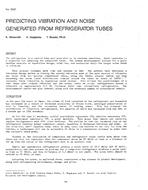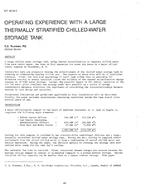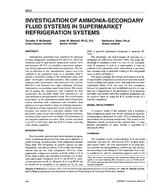Track: Fundamentals and Applications
Sponsor: Publishing and Education Council
Chair: Fu Linda Xiao, Ph.D., Member, Hong Kong Polytechnic University, Hong Kong, Hong Kong
Humidity in the built environment is usually passively controlled due to coupled heat and moisture transfer in conventional air conditioning processes. Research and development for achieving energy-efficient active humidity control, or independent temperature and humidity control in the built environment, mainly adopts two approaches. The first is to modify conventional air conditioning systems, the second to develop new energy-efficient air humidification and dehumidification technologies. This session features material on recent experimental and theoretical work on humidity control using liquid and solid desiccants and novel vapor permeable membranes, recently published in ASHRAE’s journal, “Science and Technology for the Built Environment”.
1. Experimental Study of the Flow Characteristics in a Falling Film Liquid Desiccant Dehumidifier
Hong-xing Yang, Ph.D.1, Yimo Luo, Ph.D.2, Yi Chen, Ph.D.1, Tammy Zhong Dan, Ph.D.2 and Yuanhao Wang, Ph.D.2, (1)Hong Kong Polytechnic University, Hong Kong, Hong Kong, (2)Technological and Higher Education Institute of Hong Kong, Hong Kong, Hong Kong
A detailed study on the flow characteristics in a falling film liquid desiccant dehumidifier is presented from simulation and experiments. The study was to determine the heat and mass transfer performance of the dehumidifier. A simple single-channel test rig was established for observing and describing the flow characteristics in the dehumidifier. The impacts of various variables on the flow morphology, coverage ratio, and minimum wetting rate have been analyzed. A correlation was developed to predict the minimum wetting rate of the solution flow. Besides, our new progress of this research project is also reported in this presentation
2. Heat and Mass Transfer Performance Comparison between a Direct-Contact Liquid Desiccant Packed Bed and a Liquid-to-Air Membrane Energy Exchanger for Air Dehumidification
Carey Simonson, Ph.D., Fellow Member, Gaoming M. Ge, Ph.D., Ahmed Abdel Salam, Ph.D. and Mohamed R.H. Abdel-Salam, Student Member, University of Saskatchewan, Saskatoon, SK, Canada
Liquid-to-air membrane energy exchangers (LAMEEs) are novel liquid desiccant exchangers by using semi-permeable membranes to separate the air and liquid flows. LAMEEs are able to eliminate the liquid droplets carryover and reduce flow maldistribution. In this study, the heat/mass transfer performance of a LAMEE and a direct-contact packed bed with the same volume and operating condition are compared: (1) with the same air pressure drop and (2) with the same heat/mass transfer area. The LAMEE shows 13-20% higher effectiveness at the former condition. Additionally, the impact of membrane on the heat mass transfer in the LAMEE is quantitatively evaluated.
Presented: Tuesday, January 23, 2018, 9:45-10:45 AM
Run Time: 60 min.
This is a zip file that consists of PowerPoint slides synchronized with the audio-recording of the speaker (recorded presentation), PDF files of the slides, and audio only (mp3) for each presentation.
Citation: ASHRAE Seminar Recordings, 2018 Winter Conference, Chicago, IL
Product Details
- Published:
- 2018
- Units of Measure:
- Dual
- File Size:
- 1 file , 55 MB
- Product Code(s):
- D-CH18Sem39


